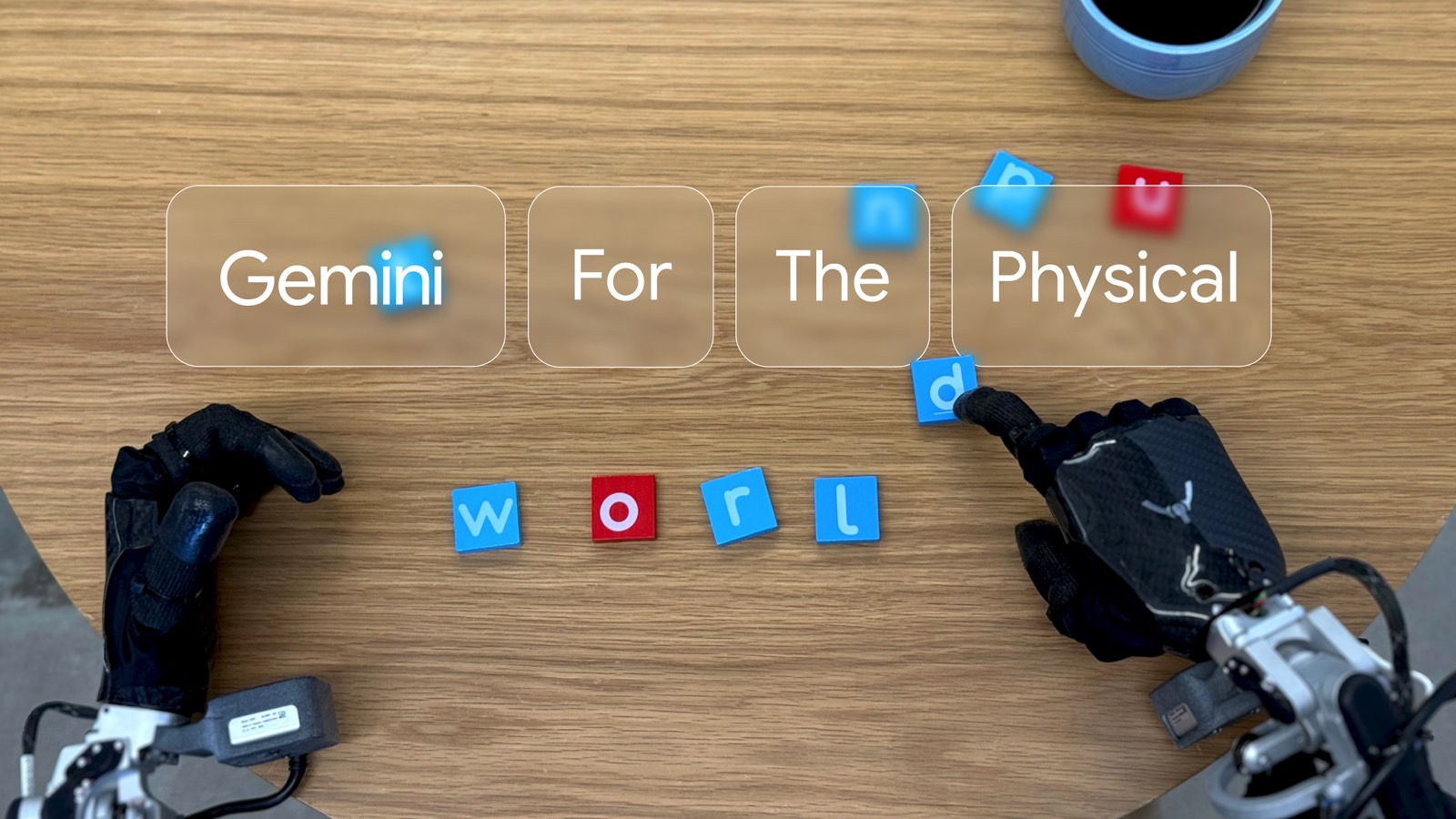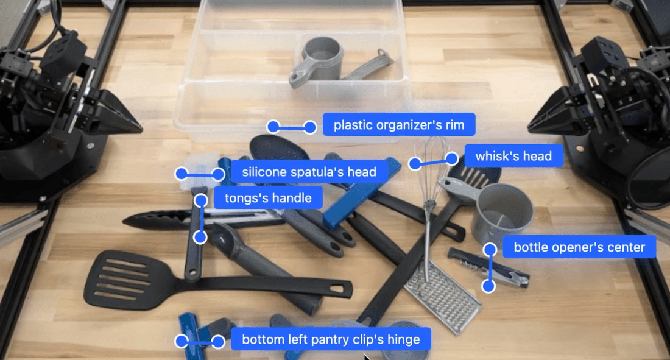Google News
Digitaltrends
1.1k

Image Credit: Digitaltrends
Gemini might soon drive futuristic robots that can do your chores
- Google announces Gemini Robotics, an initiative to bring truly general purpose robots to the world.
- Gemini Robotics aims to create robots that can adapt to different situations, understand and respond to changing environments, and perform tasks with dexterity.
- The initiative uses advanced vision-language models to enable robots to perform tasks like playing games, packing lunchboxes, and removing cards without bending them.
- Google is also developing safety guidelines and a dataset to measure and test robot behavior in the real world.
Read Full Article
5 Likes
Androidauthority
1.5k

Image Credit: Androidauthority
Google Play Store gets a smarter way to handle sideloading third-party apps
- Google Play Store has introduced a new 'Pause' feature for Play Protect.
- The new feature automatically reactivates Play Protect the next day, reducing the risk of users forgetting to turn it back on.
- This update allows Android users to sideload apps without compromising long-term security.
- The new feature aims to protect users from malware and scams while still maintaining app security.
Read Full Article
20 Likes
Arstechnica
1.3k

Image Credit: Arstechnica
Google’s new robot AI can fold delicate origami, close zipper bags without damage
- Google DeepMind has announced two new AI models, Gemini Robotics and Gemini Robotics-ER.
- These models aim to help robots better understand and interact with the physical world.
- Gemini Robotics focuses on vision, language, and action capabilities for processing visual information, understanding language commands, and generating physical movements.
- Gemini Robotics-ER focuses on embodied reasoning and enhanced spatial understanding for connecting with robot control systems.
Read Full Article
24 Likes
BGR
193

Image Credit: BGR
Google’s new Gemini Robotics AI models are blowing my mind
- Google has announced new Gemini Robotics AI models that aim to enhance robots' understanding of human commands, their surroundings, and actions they were not trained on.
- These AI models, similar to the Figure Helix Vision-Language-Action (VLA), will help robots perform tasks given by humans and interact with the physical world.
- While humanoid robot helpers for homes are still in the early stages, Google's Gemini Robotics models lay the groundwork for future advancements in AI robotics.
- The development of AI robots with physical presence to handle real-life objects is an ongoing process, with advancements in areas such as smart glasses and camera-equipped devices.
Read Full Article
11 Likes
Discover more
VentureBeat
409

Image Credit: VentureBeat
Google’s native multimodal AI image generation in Gemini 2.0 Flash impresses with fast edits, style transfers
- Google has introduced Gemini 2.0 Flash, a new experimental model offering native image generation capabilities to users of Google AI Studio and developers through the Gemini API.
- Gemini 2.0 Flash allows for multimodal image generation directly within the model, enabling greater accuracy and more capabilities compared to traditional models.
- Key capabilities of Gemini 2.0 Flash include text and image storytelling, conversational image editing, world knowledge-based image generation, and improved text rendering.
- Early demonstrations of Gemini 2.0 Flash's capabilities show impressive image generation and editing features, including pixel art style generation and colorization of black-and-white images.
- Gemini 2.0 Flash is seen as a flexible tool for design, storytelling, and visual editing among developers and AI enthusiasts.
- The rollout of Gemini 2.0 Flash's native image generation capabilities contrasts with OpenAI's GPT-4o release, showcasing Google's leadership in multimodal AI deployment.
- While some limitations were noted, such as aspect ratio issues, Gemini 2.0 Flash was praised for its swift image editing capabilities and potential applications in historical restoration and creative enhancement.
- For marketing teams, content creators, and developers, Gemini 2.0 Flash offers opportunities for cost-efficient design automation, streamlined ad creation, and enhanced AI integration into applications.
- Enterprise teams can leverage Gemini 2.0 Flash for AI-powered productivity tools, simplified image generation, and enhanced user interfaces through conversational image editing.
- Developers can begin testing Gemini 2.0 Flash's image generation features using the Gemini API, paving the way for innovative content creation, AI-assisted applications, and visual storytelling experiments.
Read Full Article
24 Likes
The Verge
130

Image Credit: The Verge
Meta is trying to ‘offload’ kids safety onto app stores with new bills, Google says
- Meta (formerly Facebook) is pushing for new laws requiring app stores to give parents control over kids' app downloads.
- Google has criticized the approach, stating that it is an attempt by Meta to offload its own responsibility to keep kids safe.
- Google believes app stores should only provide age assurance securely to developers that specifically require it for apps with risky content.
- Both Meta and Google's YouTube have previously faced criticism for not doing enough to ensure kids' safety on their platforms.
Read Full Article
7 Likes
Pymnts
215

Image Credit: Pymnts
Google, GM and Dolby Weigh In on AI in Car Systems
- Industry executives from Google, GM, and Dolby foresee cars evolving into rolling smartphones offering entertainment, productivity, and safety.
- They predict a smarter and customized future for automotive, including movie screens, productivity tools integration, video conferencing, customizable music, and gaming.
- 75% of carmakers plan to incorporate AI in vehicles within the year, with hands-free assistance features like Google Assistant and GM's Super Cruise technology already in operation.
- Super Cruise enables hands-free driving on over 750,000 miles of roads, monitoring drivers' attentiveness through sensors.
- New in-car services may come with subscription fees, offering consumers choice according to GM's senior vice president.
- The discussion at SXSW focused on in-car capabilities rather than autonomous vehicles, with GM ending its pursuit of robotaxi development.
- Dolby is collaborating with GM to bring Dolby Atmos audio technology to Cadillac vehicles, providing an immersive sound experience.
- Google and Dolby emphasize safety and user experience in vehicle technology development, working on minimizing distractions and enhancing audio clarity.
- Panelists addressed concerns like driver distraction, data privacy, and subscription services, emphasizing safety as a top priority in automotive technology advancements.
- As vehicles become more connected and autonomous, industry experts emphasize balancing technological progress with safety, privacy, and user experience.
Read Full Article
12 Likes
The Verge
251

Image Credit: The Verge
UK investigation says Apple and Google are ‘holding back’ mobile browsers
- An independent inquiry group appointed by the UK's Competition and Markets Authority (CMA) has determined that the mobile browser market in the country is experiencing issues due to the policies and practices of Apple and Google.
- The investigation found that Apple's policies, including preferential access to features for Safari and limitations on third-party web browsers, restrict competition in the mobile browser market. Google's Android ecosystem is also found to impede competition but to a lesser extent.
- The report highlights concerns around Apple's requirement for all iOS browsers to run on WebKit, Safari being pre-installed and set as the default browser on iPhones, and revenue sharing arrangements between Apple and Google, reducing incentives for competition.
- The CMA suggests potential remedies such as allowing alternative browser engines on iOS, requiring a browser choice screen during device setup, and prohibiting revenue sharing arrangements between Apple and Google. Apple and Google have not yet responded to the CMA's report.
Read Full Article
15 Likes
Gizchina
53

Image Credit: Gizchina
Google Pixel 9a Design Leaks Once Again in Case Listing
- The design of the Google Pixel 9a has once again leaked in a case listing by Spigen.
- The smartphone features a distinctive top-left pill-shaped camera island on the rear, a 6.28-inch Full HD+ OLED display, and a centered punch-hole cutout for the selfie camera.
- Internally, it is powered by the Tensor G4 chipset with 8 GB of RAM and storage options of 128 GB or 256 GB.
- The device is equipped with a dual-camera setup including a 48 MP primary sensor and a 13 MP ultrawide lens. It is expected to come with a 5,100 mAh battery and will ship with Android 15.
Read Full Article
3 Likes
Googleblog
107

Image Credit: Googleblog
Jetpack WindowManager 1.4 is stable
- Jetpack WindowManager 1.4 introduces new features for multi-window experiences on large screen devices.
- Enhancements in WindowManager 1.4 include updates to the WindowSizeClass API for custom values and breakpoint validity checks.
- Activity embedding features like activity stack pinning and pane expansion improve multi-activity apps.
- Dialog full-screen dim and enhanced posture support are other notable additions in WindowManager 1.4.
Read Full Article
6 Likes
BGR
80

Image Credit: BGR
Google Maps bug is deleting timelines, and there might not be a fix
- Some Google Maps users are unable to find their Timeline feature.
- Users are missing years of Timeline data with no option to restore it.
- There is no confirmed solution to restore the missing data.
- The issue seems to be affecting a limited number of users.
Read Full Article
4 Likes
Insider
171

Image Credit: Insider
Google shook up its Cloud sales strategy unit, internal memo reveals
- Google Cloud has restructured its strategy team to 'respond faster' to the market.
- The reorganization aims to boost sales productivity and better support Cloud's various sales teams.
- The new structure includes consolidating core Business Services into one team and creating a central Deal Management team.
- Google Cloud's sales hit $11.96 billion in Q4 2020, but still falls behind Amazon and Microsoft.
Read Full Article
10 Likes
TechCrunch
409

Image Credit: TechCrunch
Google DeepMind unveils new AI models for controlling robots
- Google DeepMind unveils new AI models called Gemini Robotics.
- Gemini Robotics enables real-world machines to interact with objects, navigate environments, and more.
- The AI models were trained to generalize behavior across different robotics hardware.
- DeepMind released a slimmed-down model, Gemini Robotics-ER, for researchers to train their own models for robotics control.
Read Full Article
24 Likes
The Robot Report
301

Google DeepMind introduces two Gemini-based models to bring AI to the real world
- Google's robotics team, with expertise in machine learning, engineering, and physics simulation, aims to tackle challenges in AI-powered robots.
- DeepMind introduces Gemini Robotics and Gemini Robotics-ER models based on Gemini 2.0 for real-world applications.
- Gemini Robotics is an advanced vision-language-action model designed to control robots directly through physical actions.
- Gemini Robotics-ER enhances spatial understanding, enabling a wider range of tasks for robots.
- DeepMind partners with Apptronik to build humanoid robots using Gemini 2.0.
- Gemini Robotics focuses on generality, interactivity, and dexterity crucial for real-world robotics applications.
- Gemini Robotics can adapt to novel situations, comprehend natural language instructions, and adjust actions dynamically.
- Gemini Robotics' dexterity allows it to tackle complex tasks like origami folding and adapt to various robot form factors.
- Gemini Robotics-ER emphasizes spatial reasoning and enables connections with existing low-level controllers.
- DeepMind prioritizes safety in robotics by integrating safety features in Gemini Robotics-ER for collision avoidance and dynamic stability.
Read Full Article
18 Likes
Cloudblog
215

Image Credit: Cloudblog
Announcing Gemma 3 on Vertex AI
- The Gemma 3 model is now available on Vertex AI Model Garden for fine-tuning and deployment.
- Gemma 3 supports Parameter-Efficient Fine-Tuning (PEFT) and optimized deployment using vLLM on Vertex AI.
- Fine-tuning Gemma 3 on Vertex AI requires a custom dataset in JSONL format.
- Choosing the right Gemma 3 variant and customizing model parameters are essential for optimal performance.
- Precision, training parameters, and optimization play crucial roles in fine-tuning large language models.
- A CustomContainerTrainingJob can be created and run for the fine-tuning process.
- Deploying Gemma 3 on Vertex AI involves provisioning an endpoint and registering the model in the Model Registry.
- Configuration settings such as serving container options, ports, predict routes, and health routes are necessary for deployment.
- Once configured, the model can be deployed to the endpoint using specified computing power and accelerators.
- The ChatCompletion API can be utilized to interact with the deployed Gemma model in applications.
Read Full Article
12 Likes
For uninterrupted reading, download the app